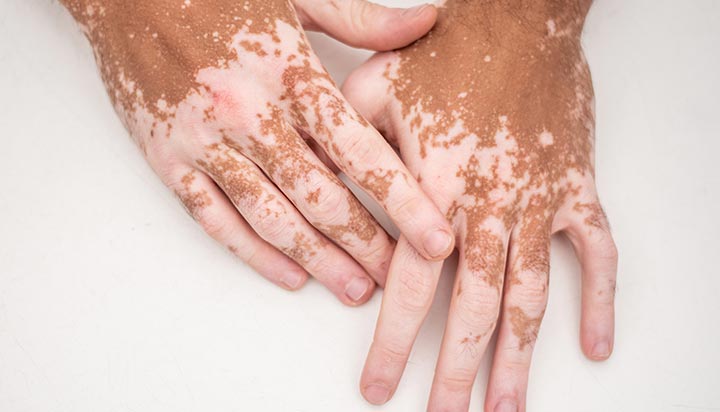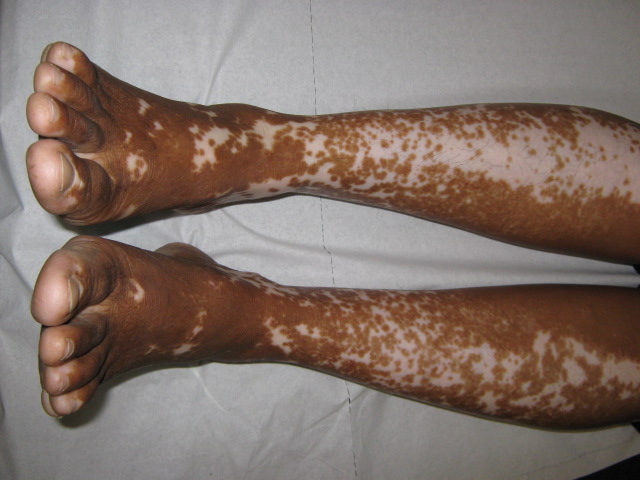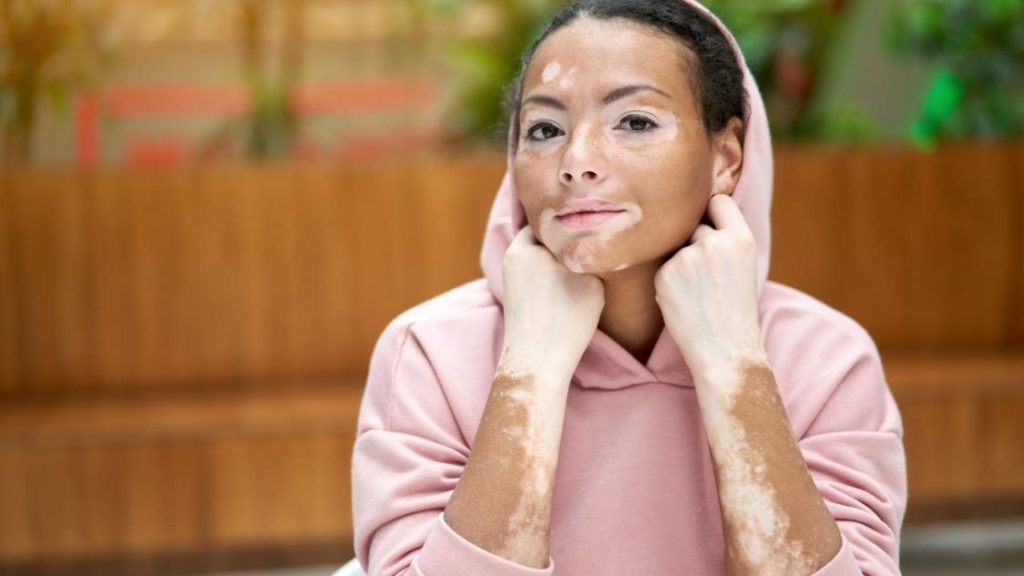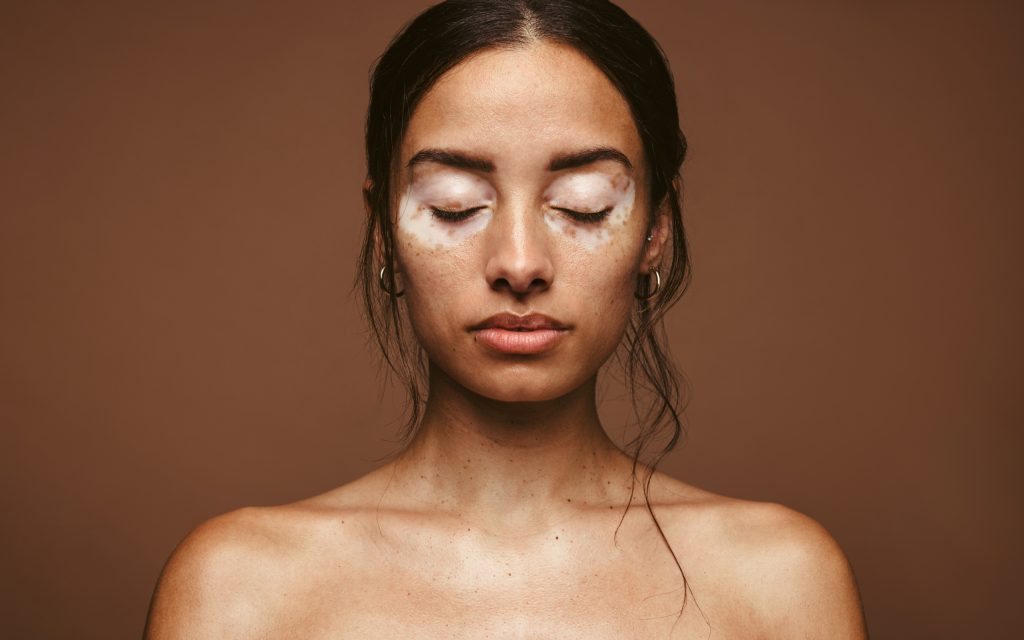Vitiligo is a chronic skin condition characterized by the loss of pigment in certain areas of the skin, resulting in white patches. This occurs when melanocytes, the cells responsible for producing melanin (the pigment that gives color to the skin, hair, and eyes), are destroyed or stop functioning properly. The exact cause of vitiligo is not fully understood, but it is believed to be an autoimmune disorder, where the body’s immune system mistakenly attacks its own pigment-producing cells. Genetic factors, stress, sunburn, or exposure to certain chemicals may also contribute to its development. Vitiligo can affect any part of the body, often appearing first on sun-exposed areas like the face, hands, and arms, and may also cause premature whitening of the hair. The condition is classified into different types, with non-segmental vitiligo being the most common, typically affecting both sides of the body symmetrically. While vitiligo is not contagious or life-threatening, it can have significant emotional and psychological impacts. Although there is no cure, treatments such as topical creams, light therapy, and in some cases, surgical procedures can help restore skin color or slow the progression. Cosmetic solutions and psychological support can also help individuals cope with the appearance and emotional effects of the condition.

Types of Vitiligo:
- Non-segmental vitiligo (more common):
- Appears on both sides of the body in a symmetrical pattern.
- Segmental vitiligo:
- Affects only one side or part of the body and tends to start at an earlier age.
Causes of Vitiligo:
Vitiligo is believed to be caused by a combination of genetic, autoimmune, and environmental factors. The most widely accepted theory is that it is an autoimmune disorder, in which the body’s immune system mistakenly attacks and destroys melanocytes—the cells responsible for producing melanin, the pigment that gives skin its color. Genetics also play a role, as vitiligo often runs in families and is associated with certain gene mutations that may increase susceptibility. Environmental triggers, such as severe sunburn, exposure to certain chemicals, or physical trauma to the skin, can also contribute to the onset or spread of the condition. Additionally, oxidative stress—an imbalance between free radicals and antioxidants in the body—may damage melanocytes. Neurogenic factors, where nerve endings release substances toxic to pigment cells, are also considered. Although emotional or physical stress does not directly cause vitiligo, it may act as a trigger or worsen existing symptoms in some individuals.
Autoimmune Response:
- The most widely accepted cause.
- The immune system mistakenly attacks and destroys melanocytes.
Genetics:
- Vitiligo often runs in families.
- Certain genes may increase susceptibility (e.g., NLRP1, PTPN22).
Environmental Triggers:
- Sunburn
- Exposure to certain chemicals or toxins
- Skin trauma (cuts, scratches, or pressure)
Oxidative Stress:
- An imbalance between free radicals and antioxidants may damage melanocytes.
Neurogenic Factors:
- Nerve endings in the skin may release substances that are toxic to melanocytes.
Emotional or Physical Stress:
- While not a direct cause, stress may trigger or worsen vitiligo in some people.

Symptoms of Vitiligo:
The most common symptom of vitiligo is the appearance of white or depigmented patches on the skin, which occur when melanocytes—the pigment-producing cells—are destroyed or stop functioning. These patches usually begin as small, pale spots and gradually enlarge over time. They often appear first on sun-exposed areas such as the face, hands, arms, feet, and lips. In addition to skin changes, vitiligo can also affect the mucous membranes, leading to a loss of pigment inside the mouth or nose. Some individuals may experience premature graying or whitening of the hair on the scalp, eyebrows, eyelashes, or beard. In rare cases, changes in eye color can occur if the pigmentation in the retina is affected. The pattern of pigment loss can vary; in non-segmental vitiligo, the patches typically appear symmetrically on both sides of the body, while in segmental vitiligo, they appear on only one side and usually progress for a limited time before stabilizing.
- White Patches on the Skin:
- Most noticeable and defining symptom.
- Usually start small and gradually spread.
- Often appear on sun-exposed areas like the face, hands, arms, feet, and lips.
- Loss of Pigment in Mucous Membranes:
- Inside the mouth or nose.
- Premature Whitening or Graying of Hair:
- Affects scalp, eyebrows, eyelashes, or beard.
- Change in Eye Color:
- In rare cases, pigment loss may affect the retina or inner layer of the eye.
- Symmetrical Pattern (in non-segmental vitiligo):
- Patches often appear in a similar pattern on both sides of the body.
- One-Sided Pattern (in segmental vitiligo):
- Patches appear only on one side or part of the body and may progress for a short time before stopping.

Solutions for Vitiligo (Treatment and Management):
Although there is no cure for vitiligo, several treatment options are available to help restore skin color, slow the progression of pigment loss, and improve the overall appearance of the skin. Topical treatments such as corticosteroid creams and calcineurin inhibitors (like tacrolimus) can help return pigment, especially when started early and used on sensitive areas like the face or neck. Light therapy, particularly narrowband UVB phototherapy, is one of the most effective treatments for widespread vitiligo, while PUVA therapy, though less commonly used, combines a light-sensitizing drug with UVA light. For people with stable vitiligo that hasn’t changed for several months, surgical options like skin grafting or melanocyte transplants may be considered. In cases where vitiligo affects most of the body, depigmentation of the remaining pigmented skin may be used to create a more uniform appearance. Cosmetic solutions, including makeup, self-tanners, or skin dyes, can also help cover white patches and improve confidence. Because vitiligo can affect a person’s emotional well-being, psychological support through counseling or support groups is often beneficial. Lastly, sun protection is essential, as depigmented skin is more vulnerable to sunburn; using broad-spectrum sunscreen and wearing protective clothing can help protect the skin and reduce contrast between affected and unaffected areas.
🔹 1. Topical Treatments:
- Corticosteroid creams – May help return pigment, especially if started early.
- Calcineurin inhibitors (e.g., tacrolimus) – Useful for sensitive areas like the face and neck.
🔹 2. Light Therapy (Phototherapy):
- Narrowband UVB therapy – One of the most common and effective treatments for widespread vitiligo.
- PUVA therapy – Combines a drug called psoralen with UVA light (less commonly used due to side effects).
🔹 3. Surgical Options (for stable vitiligo):
- Skin grafting – Transferring healthy pigmented skin to depigmented areas.
- Melanocyte transplants – Transplanting pigment cells from normal skin to white patches.
🔹 4. Depigmentation (for extensive vitiligo):
- Used when most of the skin is affected.
- Depigmenting remaining pigmented skin to create an even skin tone.
🔹 5. Cosmetic Solutions:
- Makeup, self-tanners, or skin dyes to cover patches and even skin tone.
🔹 6. Psychological Support:
- Counseling or support groups can help individuals cope with the emotional impact of vitiligo.
🔹 7. Sun Protection:
- Vital to prevent sunburn on depigmented areas.
- Use broad-spectrum sunscreen, wear protective clothing, and avoid peak sun hours.
